#underground pipe locator services
Text
Reliable Underground Pipe Locator Services
Use the trustworthy underground pipe finder services provided by C-N-I Locates LTD to ensure precise and effective utility detection. By properly identifying and mapping pipelines, our team of experts and cutting-edge technology helps you avoid costly excavation blunders. You may rely on us for time-saving solutions that improve project results.
For More Information: https://cnilocates.com/services/video-camera-pipe-inspection/
0 notes
Text
GPR Survey Services in Delhi: A Key Solution for Subsurface Investigations
In the fast-growing urban environment of Delhi, infrastructure projects and construction activities are on the rise. Whether it's building roads, laying down pipelines, or constructing large commercial spaces, there’s a growing need for thorough and accurate subsurface investigations. Ground-penetrating radar (GPR) technology has emerged as a reliable tool to help meet this demand. GPR survey services in Delhi have become essential for detecting and mapping underground utilities, voids, and other structures before any excavation or construction begins.
In this blog, we'll explore the importance of GPR survey services in Delhi, how GPR works, and why it is an invaluable asset for construction and development projects across the city.
What Are GPR Survey Services?
GPR survey services in Delhi utilize ground-penetrating radar technology to scan the subsurface of a site, providing detailed information about what lies beneath the ground. This method uses electromagnetic waves to detect and map underground utilities such as pipes, cables, and other hidden structures. The data collected from a GPR survey can help construction teams plan their work, avoiding costly mistakes, delays, or safety risks.
The technology is non-invasive and effective, making it ideal for conducting surveys in both urban and rural areas. Whether you're working on a large-scale construction project or simply need to locate specific utilities, GPR survey services in Delhi offer an efficient solution to understand the conditions below the surface.
Why GPR Survey Services Are Crucial in Delhi
Delhi, as a bustling metropolis, has a complex network of underground utilities that must be accurately located before any construction work begins. With the ever-growing demand for infrastructure development, there's a greater need for detailed subsurface data. Here are some reasons why GPR survey services in Delhi are so important:
Accurate Detection of Underground Utilities
One of the primary purposes of GPR survey services in Delhi is to detect and map underground utilities. These could include water pipes, electrical cables, gas lines, and telecom lines. Accurately identifying their location is crucial to avoid damaging them during construction. Striking a gas line or severing an electrical cable can cause significant delays, safety hazards, and increased project costs. GPR surveys offer precise detection, helping to minimize these risks.
Preventing Costly Project Delays
Construction projects often face delays due to unforeseen obstacles beneath the surface. Buried utilities or voids can lead to unexpected stoppages, forcing developers to halt work until the issue is resolved. GPR survey services in Delhi help prevent these delays by identifying potential underground challenges before work starts, allowing project managers to adjust their plans accordingly.
Ensuring Public Safety
Safety is always a top priority in any construction or excavation project. Damaging underground utilities like gas lines or electrical cables can result in serious safety hazards, putting both workers and the public at risk. By using GPR survey services in Delhi, construction teams can avoid such dangers, ensuring the worksite remains safe for everyone involved.
Supporting Efficient Infrastructure Development
Delhi's rapid development requires efficient and accurate subsurface investigations to support the construction of roads, bridges, buildings, and other essential infrastructure. GPR survey services in Delhi play a critical role in ensuring that development projects are completed on time and within budget. By providing clear, reliable data about underground conditions, GPR surveys allow for smoother project planning and execution.
How GPR Survey Services Work
Ground-penetrating radar (GPR) technology works by sending electromagnetic waves into the ground. When these waves encounter buried objects or materials, they bounce back to the surface and are detected by the radar system. The data collected from these reflections is then used to create a map of the subsurface.
Here's a brief breakdown of how GPR survey services in Delhi typically work:
Site Assessment: Before starting the GPR survey, the team will assess the site to determine the scope of the work. This includes identifying key areas to survey and understanding the project requirements.
Scanning the Ground: The GPR device is moved over the surface of the ground, sending electromagnetic waves into the subsurface. These waves interact with buried utilities or structures, and the radar system records the reflections that bounce back.
Data Collection: The GPR system collects detailed data about the underground features, including their depth, size, and location. This data is essential for accurately mapping utilities and other subsurface structures.
Data Interpretation: Once the data is collected, it is analyzed to create a clear map of the underground utilities and other objects. This information is then shared with the project team, helping them plan their construction or excavation work.
Reporting: Finally, a detailed report is generated based on the findings. This report typically includes visual maps and recommendations to guide the project team in making informed decisions.
Applications of GPR Survey Services in Delhi
GPR survey services in Delhi are used across a wide range of applications, making them invaluable for many sectors, including construction, telecommunications, and public safety. Some key applications of GPR survey services include:
Construction Projects
Before beginning any construction work, it is essential to know what lies beneath the surface. GPR survey services in Delhi help construction teams identify buried utilities, voids, and other potential hazards, ensuring that the project proceeds smoothly without any disruptions.
Utility Mapping
One of the most common uses of GPR technology is for utility mapping. Whether it's locating water pipes, electrical lines, or gas pipelines, GPR survey services in Delhi provide accurate and detailed maps of underground utilities, helping developers avoid damaging critical infrastructure.
Telecommunications
When laying down new fiber-optic cables or other telecommunications infrastructure, it’s important to know where existing utilities are located. GPR survey services in Delhi help ensure that new lines are installed without interfering with existing utilities, preventing costly damage or service interruptions.
Public Safety and Emergency Response
In emergencies, such as gas leaks or sinkholes, GPR surveys can quickly provide crucial information about the underground environment. GPR survey services in Delhi allow responders to assess the situation accurately and take appropriate action to ensure public safety.
Benefits of Using GPR Survey Services in Delhi
There are numerous benefits to using GPR survey services in Delhi, particularly for construction and development projects. Some of the key advantages include:
Non-invasive and environmentally friendly: GPR technology does not require digging or drilling, making it a non-invasive and eco-friendly option for subsurface investigations.
Cost-effective: By detecting utilities and hazards before construction begins, GPR surveys can help prevent costly mistakes and delays.
High accuracy: GPR survey services in Delhi provide highly accurate data, allowing project teams to plan their work with confidence.
Versatility: GPR technology is suitable for a wide range of applications, from mapping utilities to assessing environmental conditions.
Conclusion
In Delhi’s ever-expanding urban landscape, the need for reliable subsurface investigations is more critical than ever. GPR survey services in Delhi offer a valuable solution for detecting underground utilities, voids, and other hidden features, ensuring that construction and infrastructure projects proceed safely and efficiently. With its ability to provide accurate, non-invasive data, GPR technology has become an essential tool for developers and engineers in the city. By choosing GPR survey services in Delhi, you can prevent costly delays, enhance public safety, and support the city's continued growth.
#gpr survey services in delhi#geophysics services in Delhi#geophysics services survey in delhi#crosshole seismic in delhi#induced polarization resistivity#uphole seismic survey in delhi#crosshole downhole or uphole survey in delhi#cable and pipe locator in delhi#MASW/Remi Survey in India#underground utility mapping services in Delhi
0 notes
Text
https://purpleguide.com.au/how-underground-locating-services-ensure-project-safety/

0 notes
Link

Have you hit the underground utility line? Don't worry; accidents happen, and damages to underground utilities always happen during excavating on a location. So, if you hit the underground utility, you should get every person around you to a safe place.
Another thing you need to do is control the risks; after making sure that everyone around you is safe, now control the hazards. Contact us before you dig, and get GeoScan’s utility location services and underground utility mapping done.
Why Choose Us?
Safety and environmental management plan.
Services are available at competitive prices.
First Aid Trained and we work with children check
Fully licensed company with complete insurance coverage.
If you hit the pipe location while digging, contact us at 0417 309 710.
0 notes
Link
Pipe And Cable Locator
Even if you hire a Pipe And Cable Locator, you may encounter problems while digging near a pipe or cable. Safe digging is a technique that ensures no underground services are disrupted during the excavation process. It includes practices such as using insulated tools, marking utilities, testing air quality before excavation, and more.
0 notes
Text
Cable Locating Experts Melbourne

At Austest Pipeline Solutions, our utility locating professionals can locate the correct positions of pipes & cables underground using electromagnetic signals. You will be in safe hands with our advanced cable & pipe locating equipment so call us at 1800 532 533 where we help you find the exact underground service locations.
0 notes
Note
Hi and thank you for all the service you do for us!
If it's not too much of a bother, could you please compile everything that is known about the structure of the dungeon? The maps, the floors, and what's there, if there are notes about what monster lives where, it would be amazing! I've found a few useful panels, but I'm not sure if I'm missing anything. Thanks!
So you mean information about "The Island" in specific? That's apparently the name of the dungeon they're in during the story. I can try
You can check the dungeons tag for more general information about dungeons.
Here's what the adventurer's bible says about the Island:
1 THE ISLAND
A new dungeon that was discovered just six years ago. It's rumored that the Golden Country that existed a thousand years ago still lies in its depths, imprisoned there by the Lunatic Magician
And here's what I said about it on that Dungeons post
"The island", which is the name given to the Dungeon Linked to Melini Village's Graveyard, is a "Compound-Style Dungeon" while other dungeons seem to have specific styles linked to other ancient civilizations (Dwarf-Style, Gnome-Style, Elf-Style)
'The Island' in specific seem to be a Compound Style between dwarfish and elvish styles. As Thistle says, continuing in ch 68, it was an ancient Dwarf construction that was then used by Elves.
Maybe that's the reason the dwarfish inscriptions are only in the innermost levels of the dungeon. The Style then seems to indicate which ancient civilizations created the manmade Dungeon.

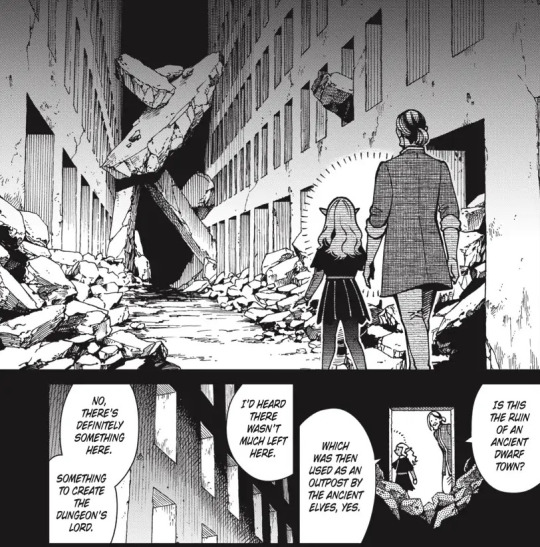
Idk much about the maps, there's some behind the characters in some covers but idk if they're accurate at all or what they represent but here they are:


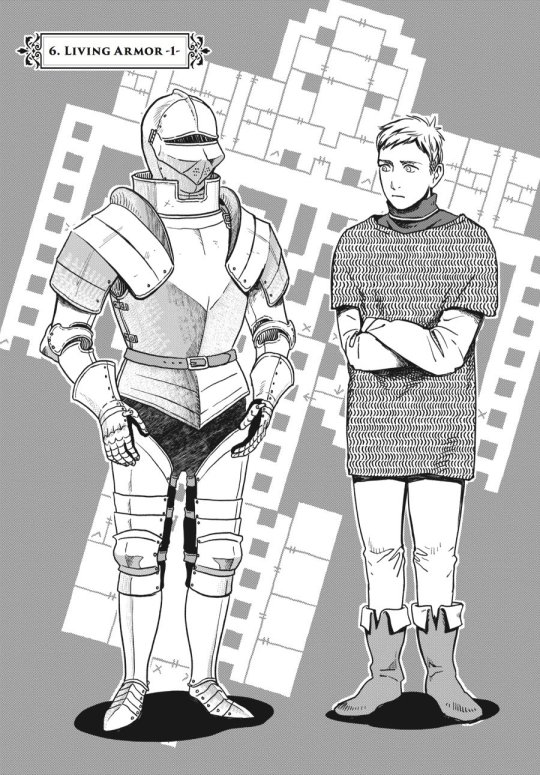



About the floors we have a cross section that shows floors from floor 1 to floor 5 and a bit of 6
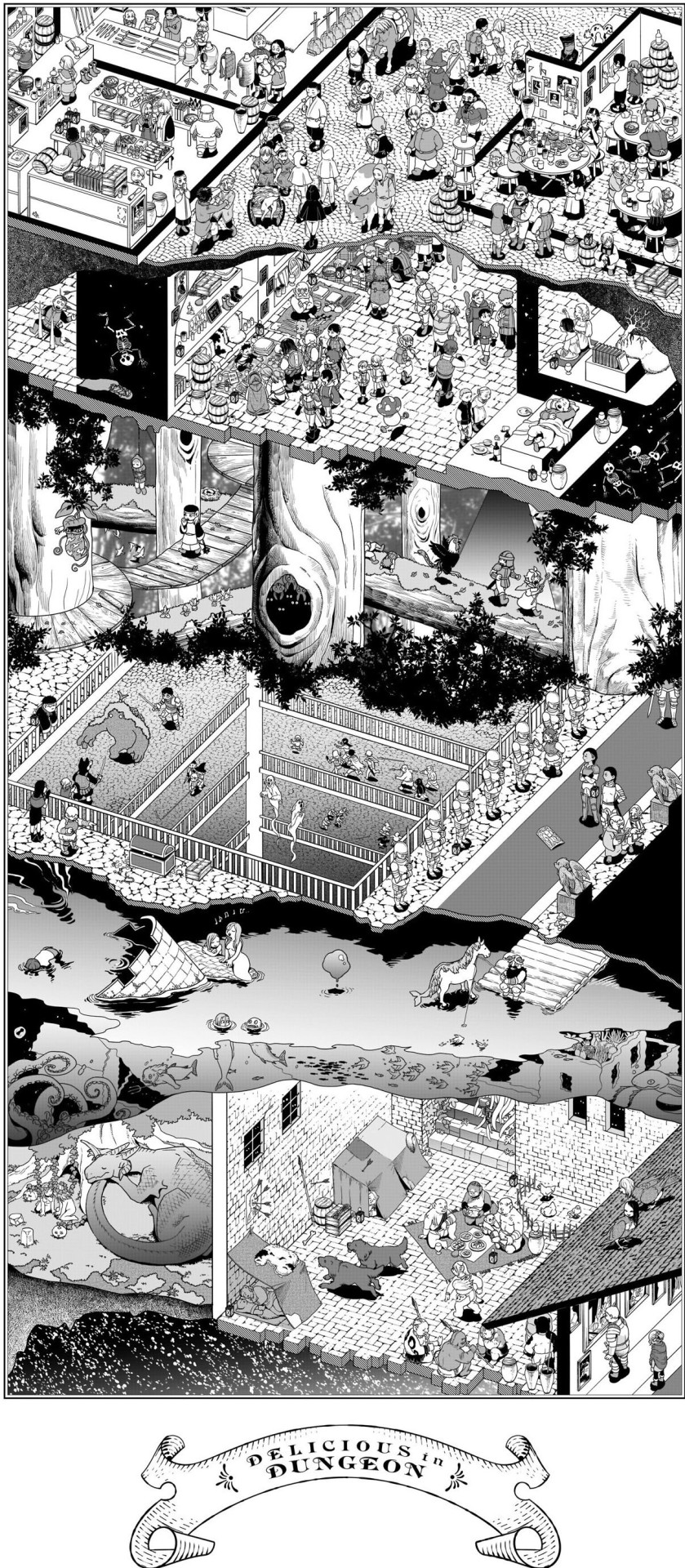
I'll just copy whats on the wiki cause I think it works and add images from the manga.
Floor 1
The uppermost floor of the dungeon. Once the graveyard of the nearby Merini Village, the discovery of the dungeon resulted in it filling with merchants and adventurers. There are sellers of manuscripts and incense, as well as an abundance of food stalls. There is also a demi-human slave market

Floor 2
The floor is filled with tall trees and towers, linked by wooden bridges. It is theorized by scholars that the area is the top of the Golden Castle sealed away by the Lunatic Magician.


Floor 3
The entrance to the Golden Castle, now moldy and covered in dust. Footsteps can be heard, but it is unclear if they are those of fellow adventurers or the undead. Most monsters on this floor are undead, rotting or skeletal. There are water fountains in the shape of lion's heads throughout the level. There are also toilets in the busier areas, which have been maintained by Senshi for many years.
Senshi's base camp is located here. There are also merchants on this level, but their clientele tend to be fairly shady.

Floor 4
The floor is a cave made up of the castle and an underground lake. The water has absorbed magical energy and glows faintly. At the bottom of the lake is the castle town.

Floor 5
The exit of the Golden Castle and the entrance to the castle town, which contain evidence of their former splendor. The streets often magically rearrange themselves, making navigation difficult. The orcs' former home is located here. There is an overgrown graveyard attached to the town that is populated by Dryads.

Floor 6
A network of underground waterways built using the mining tunnels of dwarves. It is stated that most monsters on this floor use mental attacks. This floor was once hot and humid, but is now cold and snowy.

Floor 7 (wiki calls it "Deepest part of the dungeon" but the monster guide says the monsters are on F7)
An old dwarven defensive site, filled with pipes, machinery and mechanical contraptions located past a large door with no visible lock. The floor is fairly warm. Further onward is an ancient dwarven city, hewn from the side of a cliff face, with giant fungi sprouting in some areas

--
Besides these floors there's also the Golden Kingdom and Thistle's home, the golden kingdom appears to not actually be conected to the rest of the dungeon directly? Since they need the ghosts to take them to and from there, Thistle's home seems to be past the 7th floor but might just be on the 7th I'm not sure.

About the monsters you can check on that wiki page which monsters show up on each floor (based on what shows up on the manga I think) but here's what the adventurer's bible says about which floor each ones lives:
All over the Dungeon
Walking Mushroom
Big Walking Mushroom
Dungeon Cleaner
Undine
The eyes of the Magician (Wyvern)
1F and bellow
Huge Scorpion
Green Slime (Mostly 1F)
2F and bellow
Mandrake
Man-Eating Plant
Big Bat
Basilisk (only 2F)
3F and bellow
Treasure Insects
Mimic
Living Armor (3F-5F)
Ghost
Golem
Living Painting
4F and bellow
Mermaid
Kelpie
Fish-Man
Giant Frog
Sea Serpent
Ivy Tentacles
Tentacles
Giant Kraken (only 4F)
5F and bellow
Dryad
Minotaur
Warg
Harpy
Cockatrice
Wyvern
6F and bellow
Barometz
Changeling
Shapeshifter
Hippogriff
Griffin
Nightmare
Red Dragon
Green Dragon
7F and bellow
Dungeon Rabbit
Bicorn
Unicorn
Succubus
Dullahan
Gargoyle
- (No habitat in the dungeon, were summoned by the Dungeon Lord)
Phoenix
Familiars
Hag
White Dragon
Easter Dragon
Wurm
Chimera
Flying Pig
Jackalope
Werewolf
Huge Spider
Quetzalcoatl
Hope all of this helps somehow!! Putting a readmore fucked up the formatting so I hope yall don't mind the huge post 😅
#Dungeon Meshi#Dungeon Meshi Spoilers#Dungeons#Worldbuilding#The Island#Dungeon#Monsters#Floors#Lore ask#ask#long post#for referencing#longpost
149 notes
·
View notes
Text
Headcanons surrounding the abbey, the siblings, and the ghouls. Let's go.
-The abbey is a mix of new and old architecture, with an emphasis on cohesively blending the newer wings with the older parts of the building, at least from an aesthetic standpoint.
However, there are some parts of the abbey that have been intentionally cut off by modern additions, in other words; There are parts of the abbey that are visible form the outside, but completely inaccessible from within.
These parts of the abbey are either structurally unsound, thus dangerous for anyone to venture into, or have been sealed for reasons unknown.
As a result of this decision to conceal rather than demolish these areas, the abbey has a very mazelike layout akin to the Winchester Mansion, and new and old siblings of sin are often seen consulting maps to find their way around.
-The basement where the ghouls reside/where their dorms are housed is NOT the abbey's "real" basement; The abbey's actual basement, where the electrical panels and pipes feed down to, is only accessible through two points on the property.
The first entrance is located through a door labeled, "Custodial Services Only", and is pretty obvious, given that the door itself is painted bright red and has a keypad beside it, whereas the other one is located... somewhere.
Yeah, no one actually knows where the second entrance is, but it's somewhere outside.
The ghouls also have another way of getting into the actual basement, but that's because ghouls really love to dig.
-Speaking of weird shit underground, if it wasn't bad enough that the abbey is a maze, there's plenty of places where one could accidentally wind up in the catacombs, because, yeah, not only do they have two basements, they have a tunnel of bones, too!
Mountain says it used to be used for burials back in the olden days, but that it eventually took on a more sinister history that he prefers not to delve into.
Dew sometimes hangs out down there with "the nuns", and he won't elaborate more on what he means by that, and everyone is lowkey a little concerned.
-On the topic of the nuns though... Yeah, there's a bunch of dead nuns floating around the place, which may or may not be the reason why the library is so fucking haunting, but we digress.
Many of the siblings report seeing apparitions of nuns -not sisters of sin in their habits, straight up nuns- traveling through some of the more secluded hallways, and on occasion one of the old chapels seems to be filled with the sounds of prayers spoken in Latin despite the room itself being condemned and empty.
This is another place where Dew can be found from time to time, seemingly having conversations with the air.
-The infirmary is one of the newer additions to the abbey, as the older wing dedicated to medical services was bricked shut during renovations decades ago and has been left to rot ever since.
There's a challenge among the medical staff, ghouls included, in which they have to travel from the infirmary to the old wing, touch the wall where the door used to be, and come back, and there are marks from where they've placed their hands there.
Aether undertook this mission solo after his retirement, needing to feel some kind of connection to the abbey and leave his mark, and truth be told he's never quite been the same since.
According to him, once you see the wall, it's impossible not to feel different.
"You'll always know someone is looking out for you... whether you like it or not."
And lastly;
-There's a rumor among the siblings that there's a secret cemetery in the woods surrounding the abbey, but no one has been able to find it... at least no one who's lived to tell the tale.
Many more scientifically minded folks think these individuals may have fell victim to sinkholes or one of the edgeless, cavernous wells -such as Ol' Dens' Pond- that have cropped up over the years, but no one can say for certain.
In a way, perhaps, it is a self made graveyard, born of aimless wandering and a lack of caution.
Though the worn crosses turned to naught moss covered stones beg to differ.
#lamp rambles#shitghosting#nameless ghouls#dewdrop ghoul#aether ghoul#mountain ghoul#ghost band#the band ghost#ghost bc#ghost band headcanons#nameless ghoul headcanons#sibling of sin#sister of sin#sibling of sin headcanons#sister of sin headcanons
104 notes
·
View notes
Text
What should you do if your dog dies of natural causes?

Losing a beloved dog is one of the most heartbreaking experiences for any pet owner. As you navigate through this difficult time, choosing to bury your dog at home can provide a sense of closeness and allow for a personal and heartfelt farewell. However, there are several important factors to consider to ensure that the burial is conducted safely, legally, and respectfully. Here are the key points to pay attention to when burying your dog.
1. Check Local Laws and Regulations
Before proceeding with a home burial, it's crucial to verify local laws and regulations. Some municipalities have specific rules regarding pet burials, such as restrictions on home burials, required burial depths, or mandates for certain types of containers. Contact your local health department or municipal office to obtain the necessary information and ensure you comply with local ordinances.
2. Choose an Appropriate Location
Selecting the right location for your dog's final resting place is essential. Choose a peaceful and secluded spot on your property that is unlikely to be disturbed in the future. Avoid areas near water sources, gardens, or places with high foot traffic. Ensure the chosen location is not prone to flooding, which could expose the grave and cause distress.
3. Digging the Grave
The grave should be deep enough to prevent other animals from disturbing the remains. A depth of at least 3 to 4 feet is recommended. The grave should also be wide and long enough to accommodate your dog comfortably. Use a sturdy shovel, and take your time to dig the grave properly, ensuring it is secure and respectful.
4. Consider a Burial Container
Using a burial container such as a biodegradable coffin or a shroud can provide added protection and dignity. Biodegradable options are environmentally friendly and will decompose naturally over time. Make sure the container is appropriately sized for your dog and that it aligns with any local regulations.
5. Handle Your Dog with Care
Gently place your dog in the chosen burial container or directly into the grave. Handle their body with respect and love, allowing yourself time for a final goodbye. This moment can be very emotional, and it's important to approach it with care and tenderness.
6. Mark the Grave
Marking the grave is a personal choice that can help you remember the burial site. Options include a simple wooden marker, a stone, or a personalized plaque. Some pet owners choose to plant a tree or flowers at the site as a living memorial. Ensure that the marker is durable and weather-resistant if you plan to visit the site regularly.
7. Consider the Surrounding Environment
Be mindful of the surrounding environment when choosing the burial site. Avoid areas that may be developed or altered in the future. Ensure that the site is not close to any underground utilities or pipes. This foresight will help prevent future disturbances to your pet's resting place.
8. Prepare Emotionally and Practically
The process of burying your dog can be emotionally taxing. Consider enlisting the help of family members or friends for both emotional support and practical assistance. Taking the time to prepare mentally for this process can help you manage your emotions and ensure that the burial is conducted with the dignity your pet deserves.
9. Think About Future Considerations
Consider how you might want to memorialize your dog in the future. Some pet owners create a small garden around the burial site or add a bench for quiet reflection. Planning for these additions can provide ongoing comfort and a special place to remember your beloved pet.
10. Seek Professional Help if Needed
If you find the process too overwhelming or if local regulations are complex, consider seeking professional help. Pet burial services can handle the logistics and legalities, ensuring that your pet's burial is conducted appropriately. These services often provide options for memorials and can guide you through the entire process with compassion.
Burying your dog at home can be a deeply personal and meaningful way to say goodbye. By paying attention to local laws, choosing an appropriate location, handling the burial with care, and considering future memorials, you can create a respectful and lasting tribute to your beloved pet. This process, though challenging, can provide comfort and a sense of closure during a difficult time. Always remember to seek support and take care of your emotional well-being as you navigate through this profound loss.
#dog#pet#my pets#pets#cute animals#puppy#animal#cat#doggo#bd/sm pet#dogs of tumblr#bungou stray dogs#dog news#dogday#dogblr#cats
18 notes
·
View notes
Text
Hurricane Michael unearths hidden history at ‘Negro Fort’ where 270 escaped slaves died – ASALH – The Founders of Black History Month
https://asalh.org/hurricane-michael-unearths-hidden-history-at-negro-fort-where-270-escaped-slaves-died/
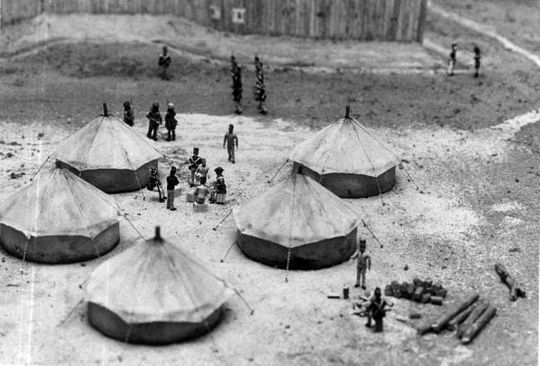
PROSPECT BLUFF — Two hundred years ago, a post overlooking the Apalachicola River housed what historians say was the largest community of freed slaves in North America at the time.
Hurricane Michael has given archaeologists an unprecedented opportunity to study its story, a significant tale of black resistance that ended in bloodshed.
The site, also known as Fort Gadsden, is about 70 miles southwest of Tallahassee in the Apalachicola National Forest near the hamlet of Sumatra.
British lived at Prospect Bluff with allied escaped slaves, called Maroons, who joined the British military in exchange for freedom, along with Seminole, Creek, Miccosukee and Choctaw tribe members.
The Negro Fort, which was built on the site by the British during the War of 1812, became a haven for escaped slaves. Inside, 300 barrels of gunpowder were stored, and defended by both women and men.
More:The Negro Fort: a haven for escaped slaves that fell to deadliest cannon shot in U.S. history
Wary of the group of armed former slaves in Spanish Florida living so close to the United States border, U.S. soldiers began to attack. On July 27, 1816, U.S. forces led by Colonel Duncan Clinch ventured down the river and fired a single shot at the fort’s magazine. It exploded, killing 270 escaped slaves and tribes people who were inside. Those who survived were forced back into slavery.
Managed by the U.S. Forest Service, which purchased it in the 1940s, the site has been preserved as a National Historic Landmark and park. Because of that, it was never excavated for artifacts, except in 1963 by Florida State University, mainly to identify structural remains.
“It’s a really intriguing story. There’s so much new ground there that historians of the past never really got into,” said Dale Cox, a Jackson County-based historian.
In an ironic way, Hurricane Michael has changed that — an isolated upsideof the devastating storm.
The October Category 5 hurricane caused extensive damage to the site, toppling about 100 trees. Most of the debris has been cleared, but under the remaining massive roots, archaeologists began this month to dig and sift through the soil, uncovering small artifacts and documenting archaeological features revealed by the upturned trees.
The effort is funded by a $15,000 grant awarded from the National Park Service and is in partnership with the Southeast Archaeological Center.
"The easy, low-hanging fruit is European trade ware that dates to that time period. But when you have ceramics that were made by the locals, it's even more unique and special," said U.S. Forest Service Archaeologist Rhonda Kimbrough. "For one thing, there's not much of it, and we don't have a whole lot of historical records other than the European view from what life in these Maroon communities was like."
So far, Kimbrough and others have found bits of Seminole ceramics, shards of British black glass and gun flint and pipe smoking fragments. They’ve also located the area of a field oven, a large circular ditch that surrounds a fire pit.
The fort was recently inducted into the National Park Service’s Underground Railroad Network to Freedom.
"It’s like connecting the sites, pearls on a string," said Kimbrough, "because these sites, even though they’re spread all over the place, they’re connected by one thing, which is resistance to slavery."

It's been a slow process of sifting through Census records, which are private for 72 years before release, international archives of Great Britain as well as Spanish archives in Cuba. But Cox is on a quest to name as many as possible.
The people who lived in the Maroon community were very skilled, he said. Many were masons, woodworkers, farmers. They tended the surrounding melon and squash fields, but little is known precisely about their day-to-day lives.
The area has always been ideal for settling, given its higher elevation and clearings amid the river's mostly swampy perimeter, said Andrea Repp, a U.S. Forest Service archaeologist. Prior to European occupation, the site was sacred to natives and was named Achackweithle, which resembles the words for "standing view" in Creek, according to the Florida Geological Survey.
Shack, 76, is a descendant of Maroons. His great great grandfather escaped a North Carolina plantation, married a part-Native American woman and settled in Marianna. He remembers his grandmother's stories about the Prospect Bluff community.
"I remember her telling us about the 'Colored Fort' and all the colored folk who died," he said. "A lot of black history wasn't taught. A lot of our history is lost, and some of it we won't get back. I'm glad that there's a renewed interest in capturing the history that I thought was lost."
#Hurricane Michael unearths hidden history at ‘Negro Fort’ where 270 escaped slaves died#florida#Negro Fort#Seminoles#Black Freedmen#Black
8 notes
·
View notes
Text
What Is The Role Of Underground Pipe Locator Services In Construction?
A utility locator is an expert tasked with finding and marking underground pipe locator services before any construction or project commencement. They possess the skills to interpret maps and blueprints to identify the precise locations of utilities, ensuring their protection during excavation. Additionally, locators are adept at operating vehicles and managing traffic flow around the work area, guaranteeing a safe environment. A pipe locator employs conductive or inductive techniques to locate hidden pipes with remarkable precision. For instance, a conductive pipe locator can apply a tracing signal to a coated metallic pipe through an access point like a valve or meter.
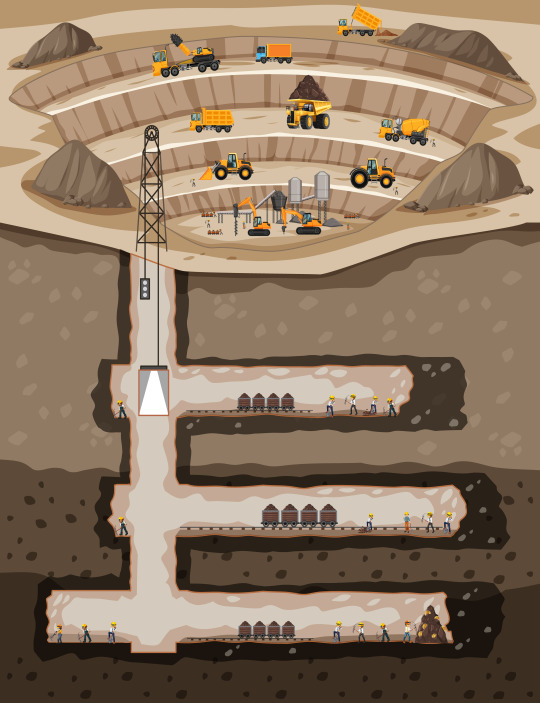
Significant Of Underground Pipe Locator Services In Construction Industry
When the moment arrives to initiate construction and excavation tasks, even the most seasoned contractor may underestimate the significance of subsurface utilities and buried materials. However, recognizing their importance for establishing a safe work environment and ensuring that the project progresses within the allocated budget and schedule.
1. Prevent Accidental Damage
Underground pipe locator services play a crucial role in recognizing the underground pipelines which should be damaged in the construction process. Such services protect the pipes from getting any accidental damage. Additionally, it saves the cost of repairing in the future.
2. Work With Regulations
Construction of a building or digging requires authorization, and permits are carefully considered while the construction. Underground utility locating ensures to follow all the rules and regulations to make your construction without any interruption. Also, it increases safety throughout the construction.
3. Enhancing The Project Planning
Before starting with the construction, you must require project planning which makes you aware of the need in the process. By providing detailed information about the depth, an underground water leak detection company becomes an integral part of the project planning.
Hire An Experienced Company For All Your Needs Today!
A professional who has experience and knows about professionalism provides you peace of mind in your construction process. If you are wondering whom to contact for underground pipe locator services, contact C-N-I Locates LTD. They provide utility locate services for commercial and residential properties. In addition, they have been working in this field for years with various advanced technologies. Connect with them today and know more about their services to make your construction hassle-free.
#underground pipe locator services#underground utility locating#underground water leak detection company
0 notes
Text
Understanding Crosshole Seismic Testing in Delhi: A Comprehensive Guide
When it comes to construction, particularly in a bustling city like Delhi, understanding the soil and rock properties beneath a site is crucial. One of the most effective ways to obtain this understanding is through crosshole seismic in Delhi. This blog will explore what crosshole seismic testing is, why it's important, and how it is conducted, with a focus on its application in Delhi.
What is Crosshole Seismic Testing?
Crosshole seismic testing is a geophysical method used to determine the properties of the subsurface material, such as soil or rock. The test involves creating small, parallel boreholes at a site and then using seismic waves to measure the velocity through the subsurface materials. These measurements provide detailed information about the subsurface structure, which is essential for engineering and construction projects.
In a rapidly growing city like Delhi, where construction is booming, crosshole seismic in Delhi has become increasingly important. This testing method allows engineers and architects to make informed decisions based on the actual conditions of the site.
Importance of Crosshole Seismic Testing in Delhi
Delhi is known for its diverse geological formations, ranging from ancient riverbeds to hard rock layers. This complexity requires a reliable method to assess the subsurface conditions accurately. Crosshole seismic in Delhi offers several key benefits:
Accurate Subsurface Profiling: Crosshole seismic testing provides a highly accurate profile of the subsurface conditions, which is critical for designing foundations, tunnels, and other structures in Delhi.
Safety Assurance: By understanding the subsurface conditions, engineers can ensure the safety of the structures built on the site. This is especially important in a city like Delhi, where earthquakes are a concern.
Cost-Effective Construction: Knowing the subsurface conditions can help in selecting the appropriate construction techniques and materials, potentially saving costs in the long run.
Environmental Protection: Crosshole seismic in Delhi helps in minimising the environmental impact of construction by avoiding unnecessary excavation and reducing the risk of damaging underground utilities or natural resources.
How Crosshole Seismic Testing is Conducted
The process of crosshole seismic in Delhi involves several steps, each crucial for obtaining accurate results:
Borehole Drilling: The first step is to drill small, parallel boreholes at the site. The number of boreholes and their depth depends on the specific requirements of the project.
Seismic Source Placement: A seismic source, usually a small explosive charge or a mechanical hammer, is placed in one of the boreholes. This source generates seismic waves that travel through the subsurface.
Seismic Wave Recording: Geophones, which are sensitive to seismic waves, are placed in the other boreholes to record the waves as they pass through the subsurface materials.
Data Analysis: The recorded data is analyzed to determine the velocity of the seismic waves. This information is used to create a detailed profile of the subsurface conditions.
Applications of Crosshole Seismic Testing in Delhi
Crosshole seismic in Delhi is widely used in various construction and engineering projects. Some of the most common applications include:
Foundation Design: Understanding the subsurface conditions is crucial for designing strong and stable foundations. Crosshole seismic testing helps in determining the depth and type of foundation needed for a particular site.
Tunnel Construction: Delhi's expanding metro network and other infrastructure projects often require tunnel construction. Crosshole seismic in Delhi provides valuable information about the rock and soil conditions, which is essential for safe and efficient tunneling.
Seismic Hazard Assessment: Given Delhi's location in a seismically active zone, it is important to assess the potential impact of earthquakes on structures. Crosshole seismic in Delhi helps in evaluating the seismic hazards and designing earthquake-resistant structures.
Site Investigation for High-Rise Buildings: The construction of high-rise buildings in Delhi requires a thorough understanding of the subsurface conditions to ensure stability and safety. Crosshole seismic testing provides the necessary data for designing these structures.
Challenges and Considerations
While crosshole seismic in Delhi is a highly effective method, it does come with its challenges. Some of the key considerations include:
Borehole Placement: The accuracy of the test depends on the proper placement of boreholes. In a densely populated city like Delhi, finding suitable locations for boreholes can be challenging.
Urban Noise: Delhi is a bustling city with a lot of noise from traffic, construction, and other activities. This noise can interfere with the seismic wave recordings, making it important to conduct the test during quieter times.
Permitting and Regulations: Drilling boreholes and conducting seismic tests in Delhi requires permits and adherence to local regulations. It is important to work with experienced professionals who understand the legal requirements.
Interpreting Results: The data obtained from crosshole seismic in Delhi needs to be interpreted by skilled geophysicists and engineers to ensure accurate conclusions. Misinterpretation can lead to incorrect decisions and potentially costly mistakes.
Conclusion
In conclusion, crosshole seismic in Delhi is a vital tool for anyone involved in construction or engineering in the city. This testing method provides detailed information about the subsurface conditions, helping to ensure the safety, stability, and cost-effectiveness of construction projects. Whether it's for foundation design, tunnel construction, or seismic hazard assessment, crosshole seismic testing is an indispensable part of the process.
As Delhi continues to grow and develop, the importance of reliable and accurate geophysical testing methods like crosshole seismic will only increase. By investing in proper site investigation, developers and engineers can contribute to the safe and sustainable growth of the city.
#crosshole seismic in delhi#gpr survey services in delhi#geophysics services in Delhi#geophysics services survey in delhi#underground utility mapping services in Delhi#MASW/Remi Survey in India#cable and pipe locator in delhi
0 notes
Photo




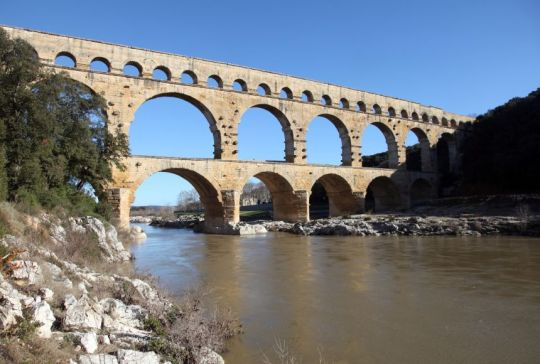
Ancient Roman Pipelines Discovered in Crete
Ongoing construction work on a new highway on the island of Crete revealed parts of an ancient water transport pipeline built during the period of Roman rule on the island.
The archaeological discovery reportedly consists of a water transport pipe that was part of the Roman aqueduct of Hersonissos.
Aqueducts were an essential element of Roman infrastructure across the empire, including in ancient Greece. They ensured the availability of fresh water in densely populated urban areas where demand was high.
Roman aqueduct discovered in Crete
Manolis Makrakis, the head of the Directorate of Primary Education of Lasithi, spoke at length about the discovery of parts of the Roman aqueduct on Crete.
“The section of the pipeline is located 5 km south of the national hub of Hersonissos and came to light, as part of the works for the opening of the road that will connect BOAK with the airport of Kastelli,” said Makrakis.
“The pipeline carried water from Kalo Chorio and Krasi to the Peninsula. It consists of two parts, an open (groove) width of approx. 40cm and a clay (closed) one with a diameter of approx. 25cm. We are waiting for more information from the archaeological service,” he added.
Historical context
Makrakis, who authored the book Story of Crete, spoke at length about the history of Roman aqueducts and water transport pipelines on the island during antiquity.
Quoting an extract from the book, Makrakis explained “The aqueduct of Hersonissos was a great work of the Roman era. The Romans were leaders in similar projects. Because the morphology of the land consists of ups and downs, they made the necessary works with the water bridges so that the water flows smoothly in the groove above the bridges. In many places, this groove was supported by wall constructions.”
“Its length was 14km, it took the water from two sources located at a great distance from each other,” the author continued. “The first source was located at the “Leontari” location in Krasi, while the second one was 3 meters south of the tap of the community reservoir of Kalos Horiou Pediados.”
“Then the two pipelines joined into one that ended in the Peninsula. The transport capacity of the pipeline was twice that of Lyktos. The pipeline passed through gullies, ravines and steep (inclined) slopes), through the uneven surfaces of the mountains and ended at the Peninsula.”
“The water of the pipeline was collected in a very large tank located on a hill south of the Port of Hersonissos at the “Palatia” location. This covered vaulted tank was 58m long, 22m wide, and 5.5m deep. The 4.5m underground section was carved out of natural rock. The thickness of the western walls was 1.60m.”
The Romans ruled Crete from 67 BC and they developed infrastructure such as aqueducts in and around the island’s pre-existing ancient Greek cities.
By Alexander Gale.
#Ancient Roman Pipelines Discovered in Crete#roman aqueduct#archeology#archeolgst#ancient artifacts#history#history news#ancient history#ancient culture#ancient civilizations#roman history#roman empire
32 notes
·
View notes
Text
Avoid Costly Delays: How Scanning Utility Locating Saves You Time and Money
In today's fast-paced construction and infrastructure development landscape, time is money. Any unforeseen delays can significantly inflate costs and disrupt project timelines. One of the most effective ways to mitigate these risks is by employing advanced scanning utility locating techniques. Safe Scanners, a leader in this field, offers state-of-the-art GPR Services, GPR Scanning, Ground Penetrating Radar, and Concrete Scanning Services. These services ensure that projects proceed smoothly, without the costly interruptions caused by unforeseen utility line strikes or structural issues.
The Importance of Utility Locating Services
Before any excavation, drilling, or construction work begins, it's crucial to know what lies beneath the surface. Utility locating services help identify the presence of underground utilities such as water pipes, gas lines, electrical cables, and telecommunications infrastructure. Unintended strikes on these utilities can cause severe delays, legal liabilities, safety hazards, and increased costs.
Safe Scanners' Utility Locating Services use advanced technology to provide accurate and reliable subsurface information. This proactive approach not only prevents damage but also enhances project planning and efficiency.
How Ground Penetrating Radar (GPR) Works
Ground Penetrating Radar (GPR) is a non-destructive method that uses radar pulses to image the subsurface. GPR Scanning involves transmitting high-frequency radio waves into the ground. When these waves encounter a buried object or a boundary between different materials, they reflect back to the surface, where they are detected by a receiver. The time it takes for the radar waves to return is used to create a detailed image of the subsurface.
GPR Services provided by Safe Scanners are invaluable in detecting utilities, voids, rebar, and other structural components. This technology is highly effective in a variety of materials, including soil, rock, concrete, and asphalt, making it versatile for different construction needs.
Benefits of GPR Scanning and Concrete Scanning Services
Accuracy and Precision: GPR Scanning delivers highly accurate results, allowing construction teams to pinpoint the exact location and depth of utilities and other subsurface features. This precision reduces the risk of damaging existing infrastructure and ensures compliance with safety regulations.
Cost Savings: By identifying and avoiding utilities and other subsurface hazards, Safe Scanners' GPR Services prevent costly repairs, project delays, and potential legal issues. The upfront investment in scanning services can save significant amounts of money in the long run.
Safety Enhancement: Excavating without proper knowledge of underground utilities can lead to dangerous situations, including gas leaks, electrical hazards, and water main breaks. Using Ground Penetrating Radar and Concrete Scanning Services minimizes these risks, protecting workers and the public.
Non-Destructive Testing: GPR is a non-invasive method that does not disturb the surveyed area. This means that the site remains intact, avoiding the mess and potential damage associated with exploratory digging.
Versatility: GPR Scanning can be used in various environments and for multiple applications, from large-scale construction projects to smaller residential renovations. Safe Scanners' expertise ensures that each project benefits from tailored solutions.
Case Studies: Real-World Applications of GPR
Case Study 1: Urban Infrastructure Development
In a major city development project, Safe Scanners was enlisted to perform GPR Scanning before the installation of new utilities. The dense urban environment posed a challenge due to the existing network of underground utilities. Using advanced Ground Penetrating Radar, Safe Scanners successfully mapped out the complex subsurface layout, allowing the construction team to proceed without incident. This avoided potential delays and saved the city significant costs in rerouting and repairs.
Case Study 2: Historic Building Renovation
A historic building undergoing renovation required Concrete Scanning Services to locate rebar and voids within its foundation. Safe Scanners deployed its GPR technology to scan the concrete structure, providing detailed imagery of the rebar patterns and any hidden voids. This information was crucial in planning the renovation work, ensuring structural integrity and preserving the building's historical value. The project was completed on time and within budget, thanks to the accurate data provided by Safe Scanners.
Future Trends in Utility Locating and GPR Technology
As technology advances, the capabilities of GPR and utility locating services continue to expand. Innovations such as 3D GPR imaging and real-time data processing are enhancing the accuracy and speed of subsurface investigations. Safe Scanners is at the forefront of adopting these new technologies, ensuring that clients benefit from the latest advancements in the field.
Moreover, the integration of GPR data with Geographic Information Systems (GIS) allows for more comprehensive and accessible mapping of subsurface utilities. This integration provides a holistic view of the project site, further reducing risks and improving planning efficiency.
In the realm of construction and infrastructure development, avoiding costly delays is paramount. Safe Scanners' GPR Services, including GPR Scanning, Ground Penetrating Radar, and Concrete Scanning Services, offer a reliable and effective solution to this challenge. By accurately locating subsurface utilities and other features, these services save time, reduce costs, and enhance safety on job sites.
Investing in advanced utility locating services is a proactive step that pays off in both the short and long term. With Safe Scanners' expertise and cutting-edge technology, you can ensure your projects proceed without unexpected interruptions, keeping your timelines and budgets intact.
For more information on how Safe Scanners can assist with your next project, visit our website or contact us directly. Together, we can build a safer, more efficient future.
2 notes
·
View notes
Text
Starfall, seat of House Starfield and Medieval! Ladies Varda, Yavanna and Vána

Full list of the great noble house of Valinor can be read here.
Starfall was built within a shallow crater that spreads over twenty acres, hence its name. The sacred trees of Valinor, Laurelin and Telperion are located in this crater.
At one time, Starfall was all open gardens and walkways, but after Ungoliant attempted to destroy the sacred trees, a fortress was built around the palace and surrounding grounds. The outer curtain wall was constructed to look like a star, with watchtowers and ramparts facing every direction. A secondary curtainwall was built to secure the trees and the palace. The buildings within all have proper plumbing, thanks to gravity-fed ceramic pipes and an abundance of aquifers, springs, rivers, and lakes in the region.
1.The sacred trees of Valinor.
2.Sword Tower and Shield Tower: Home to the most experienced warriors of the Knights of the Grove.
3.The palace proper: A building rising several stories into the air, with several towers. The palace also has underground floors that house the kitchens, servants’ quarters, cellars, and an ice room. The upper floors have room for guests, the second largest library in Valinor, a great hall that has twenty hearths, along with rooms and corridors filled with art and sculptures.
4.Palace stables
5.Palace kennels for hunting dogs
6.Stables that have been set aside solely to house the horses of Starfall’s warriors and knights.
7.Smithy
8.Barracks: Much like the Shield and Sword towers, the barracks have their own kitchen and armory.
9. Kennels
10.Granary and Warehouse
11.Grace and favor towers: Each tower has small aprtments set aside for widowed spouses and minor children of fallen commanders, and for those who have provided the highest acts of service for House Starfall.
12.The healer's tower
13.Gatehouses
14. Secondary curtainwall and portcullis
House Starfield coat of arms: A five petal silver rose within a circle of seven stars, upon a midnight blue field

tags: @asianbutnotjapanese @cilil @wandererindreams @edensrose
#Medieval! au#Medieval! Ainur#Varda#Medieval! Varda#yavanna#Medieval! Yavanna#Vána#Medieval! Vána#worldbuilding#💫a world of whimsy writes
8 notes
·
View notes
Text
Vacuum Excavation Services - Precise Contractors
What is vacuum excavation used for?
Vacuum excavation, also known as hydro excavation or soft digging, is a non-destructive digging method that uses high-pressure water or air to break up soil, and a vacuum system to remove the debris. This technique is commonly used for various purposes in construction, utility maintenance, and other industries. Some of the key applications of vacuum excavation include:

Utility Locating and Exposure:
Safe Excavation around Utilities: Vacuum excavation is often used to safely expose and locate underground utilities such as water pipes, gas lines, electrical cables, and telecommunications cables. This helps prevent damage to these critical infrastructure elements during construction or excavation projects.
Potholing:
Utility Potholing: Contractors use vacuum excavation to create small, precise holes (potholes) to visually inspect and verify the location of buried utilities before conducting any major excavation work. This reduces the risk of accidental damage to underground infrastructure.
Trenching:
Trenching for Utilities: Vacuum excavation is employed for creating trenches needed for installing utilities. The non-destructive nature of the process reduces the likelihood of damaging existing utilities in the vicinity.
Debris Cleanup:
Spill Cleanup: Vacuum excavation is useful for cleaning up spills or removing loose materials in industrial settings. The vacuum system efficiently collects and transports debris without disturbing the surrounding environment.
Environmental Sampling:
Soil Sampling: Vacuum excavation can be used for collecting soil samples in an environmentally sensitive manner, without causing contamination or disturbance to the surrounding area.
Slot Trenching:
Narrow Trenching: In situations where a narrow trench is required, such as for installing small pipes or cables, vacuum excavation provides a precise method for creating these narrow slots without causing unnecessary disruption.
Cold Weather Excavation:
Frozen Ground Excavation: Vacuum excavation is particularly useful in cold climates where the ground may be frozen. The high-pressure water or air can break up the frozen soil, and the vacuum system can remove the material.
Archaeological Excavation:
Sensitive Excavation: In archaeological applications, vacuum excavation is used for delicate and precise excavation around artifacts to avoid damage.
Overall, vacuum excavation is chosen for its precision, safety, and environmental benefits compared to traditional mechanical digging methods. It minimizes the risks associated with damaging underground infrastructure and reduces the environmental impact of excavation projects.
#trenching services#hydro excavation services near me#hydro vac service near me#hydrovac contractors#trenching contractor near me#hydrovac solutions#vacuum excavation contractors near me#hydrovac excavation companies near me#hydro contractors#hydro excavation near me
2 notes
·
View notes